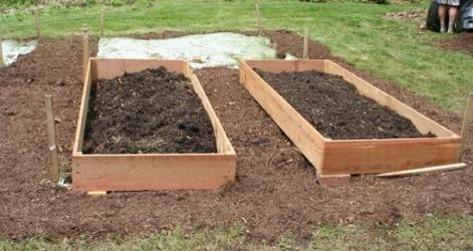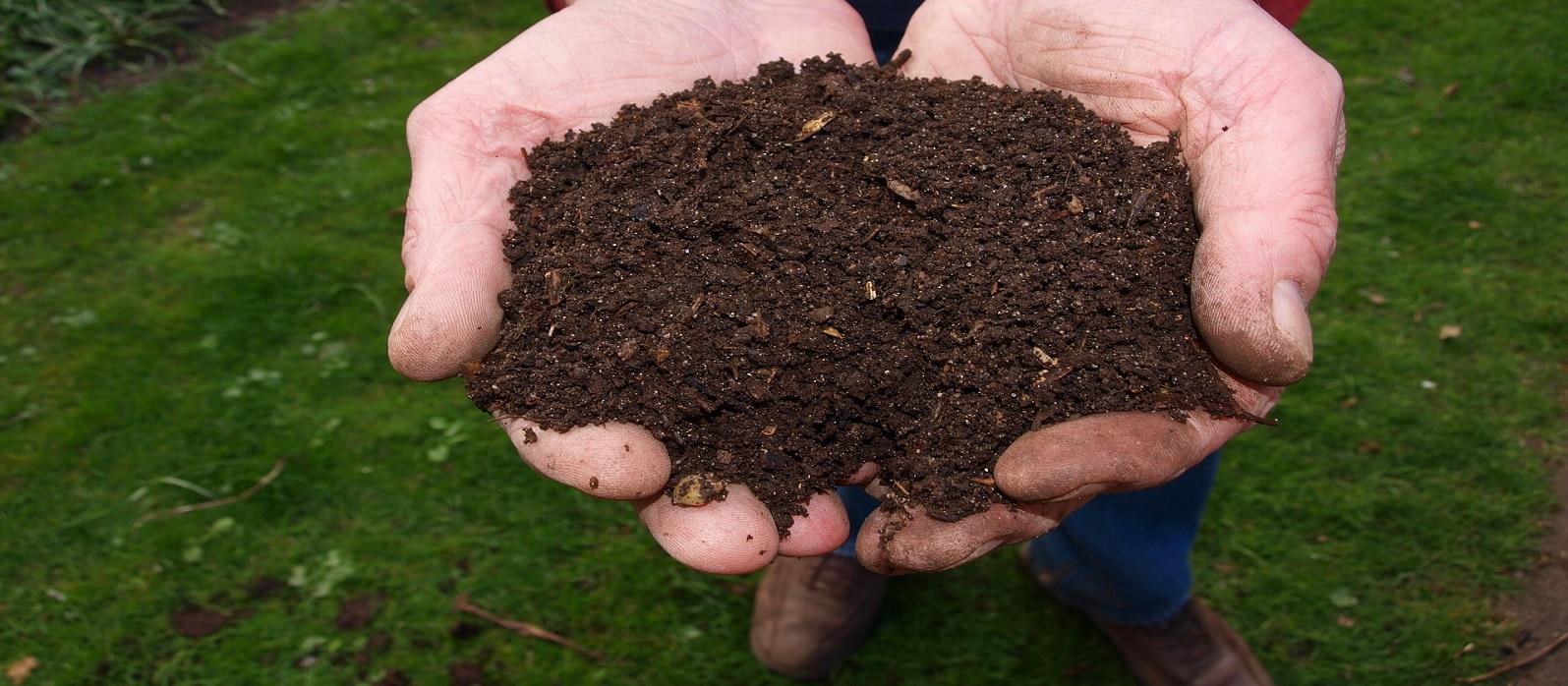Filling raised beds
- Healthy soil will help you produce healthy plants in your raised bed.
- Soil supplies plants and soil organisms with water, air, and nutrients. Ideal garden soil is loose, deep, and crumbly. It holds water for root uptake and allows excess rainfall to percolate downward quickly.
- The organic matter (OM) content in a raised bed containing garden soil, should be 25%-50% by volume or 5%-15% by weight (as measured by a soil testing lab).
Once you have your raised bed area marked off (a sunny, level site that drains well) you will need to assess the quality of the soil to make decisions about adding soil, compost, and perhaps other materials to raise the grade. The more you disturb the soil the more weed seeds you’ll bring to the surface where they can germinate. Aim for a no-till or minimum-till raised bed.
Refer to the scenarios below to learn about options and develop an approach that works best for you.
Scenario 1 - The area for raised beds has thick turf and weeds.
- Take a soil sample from the raised bed location and submit it to a soil testing laboratory (more accurate than DIY testers). Select and pay for a basic soil test. The lab will send back results (soil pH, nutrient levels, etc.) and fertilizer and soil amendment recommendations. The ideal soil pH range is 6.2-6.8 for most annuals, perennials, flowers, and vegetables.
Have the lab test the soil for lead if you plan to grow food in your raised bed. A background soil lead level of 10-50 ppm is typical. Don’t plant vegetable crops in soils with a total lead level over 400 ppm.
Prior to planting, you can add any fertilizers and soil amendments (lime, sulfur) recommended by the lab.
Test the soil one year later after the components of the raised bed have had time to fully mix and react. - In fall or early spring, lay down plain cardboard or multiple, overlapping layers of newspaper and cover with 2-4 inches of compost to hold it in place. The turf and weeds will die in 6-8 weeks and decompose in place. You can also smother the vegetation by laying down weed barrier fabric. Secure it with landscape pins, bricks, or rocks. Pull the fabric up when the vegetation is dead and spread a 2-4 inch layer of compost over the area.
-
There are two options:
- No-till: plant seeds and transplants directly into the compost. Plant roots will grow through the decomposing turf and weeds into the underlying soil. This approach will reduce the number of weed seeds that germinate in the bed.
- Minimum-till: Prior to installing a box or border, drive a garden fork or spade into the soil and rock it back and forth. Move the tool 6-8 inches and repeat. This will help loosen the soil and gently mix in the compost. (Do not lift and flip the soil over.) You can also add and mix in topsoil from your pathways to increase the soil depth.

It was filled with adjacent soil, compost, and soilless growing media. Plant roots grew through the raised bed soil into the ground below.
Photo: Jon Traunfeld, UMD
Scenario 2 - Your soil is compacted, high in clay, with little vegetation.
- Take a soil sample (refer to Scenario 1 above)
- Hand pull any vegetation or slice it off with a hoe or spade.
- Drive a garden fork or spade into the soil and rock it back and forth. Move the tool 6-8 inches and repeat. This will help loosen the subsoil which will improve drainage and aeration. (Do not lift and flip the soil over.)
- Add a mixture of compost and purchased topsoil in a 1:2 or 1:1 ratio, to the top of the bed. There are vendors who sell topsoil mixed with compost. Alternatively, fill the bed with compost and a soilless growing mix in a 1:1 ratio. You can also add and mix in topsoil from your pathways to increase the soil depth (see below). Over time the quality of the native soil below the raised bed will be improved through the addition of organic matter and root growth of crop plants.
Scenario 3 - Your raised bed is in an existing garden.
- Take a soil sample (refer to Scenario 1 above)
- Assuming that the soil is in good shape (not compacted, topsoil intact, drains well) add 2-4 inches of compost (homemade or purchased) and mix it with the top 4 inches of soil using a garden fork or spade. You can also add and mix in topsoil from your pathways to increase the soil depth (see below).
- Be prepared to manage weeds right away because any soil disturbance will bring weed seeds to the surface where they can germinate.
Scenario 4 - If your raised bed is on a non-permeable (a hard surface like a driveway) surface
- Raised bed gardens placed on hard surfaces are fine if they are a minimum of 8 inches deep for leafy greens, beans, and cucumbers, and 12-24 inches deep for pepper, tomato, and squash. These beds will dry out quickly and plants may be subject to extra stress from absorbed and reflected sunlight.
- Fill the bed with compost and a soilless growing mix in a 1:1 ratio. Topsoil can be added (up to 20% by volume) for beds that are at least 16 inches deep.
Adding pathway soil to raised bed (for Scenarios 1-3)
Use existing soil from in between your raised beds to increase the depth of soil.
- Cover 2-ft. wide pathways around the raised beds with newspaper or weed barrier to kill vegetation (allow 6-8 weeks for decomposition). Dig up the top 2-3 inches of soil and dead vegetation and add it to the raised beds. Your permanent paths can be covered with wood chips, shredded bark, brick, or heavyweight landscape fabric.
- If you don’t have time to kill the vegetation in the paths you can slice through it horizontally with a spade. Compost the weeds and grass and dig out 1-2 inches of soil that you will add to the raised bed.
Buying topsoil
-
Topsoil sales are not regulated in Maryland. If you plan to buy topsoil in bulk, go to a reputable nursery or topsoil dealer and ask for soil test results and information on the origin of the soil and on-site mixing and storage. Examine the soil before purchase or delivery. Topsoil should be dark and crumbly with an earthy smell. Do not purchase soil that is very high in sand or clay, foul-smelling, or has grayish mottling or a chalky, sticky, or rough texture. Some sellers have a mix of topsoil and compost which can make an excellent growing media for raised beds.
- The bags of “organic soil” you may see for sale typically don’t actually contain topsoil (i.e. mineral soil with clay, silt, and sand particles). These products contain various combinations of wood waste, bark fines, compost, peat moss, and other organic materials. Some of these products are certified by the Organic Materials Review Institute (OMRI) and can be used by farmers participating in the USDA organic certification program.
Written by: Jon Traunfeld, Extension Specialist; Spring, 2019. Reviewed by: Neith Little, Extension Agent, Urban Agriculture
